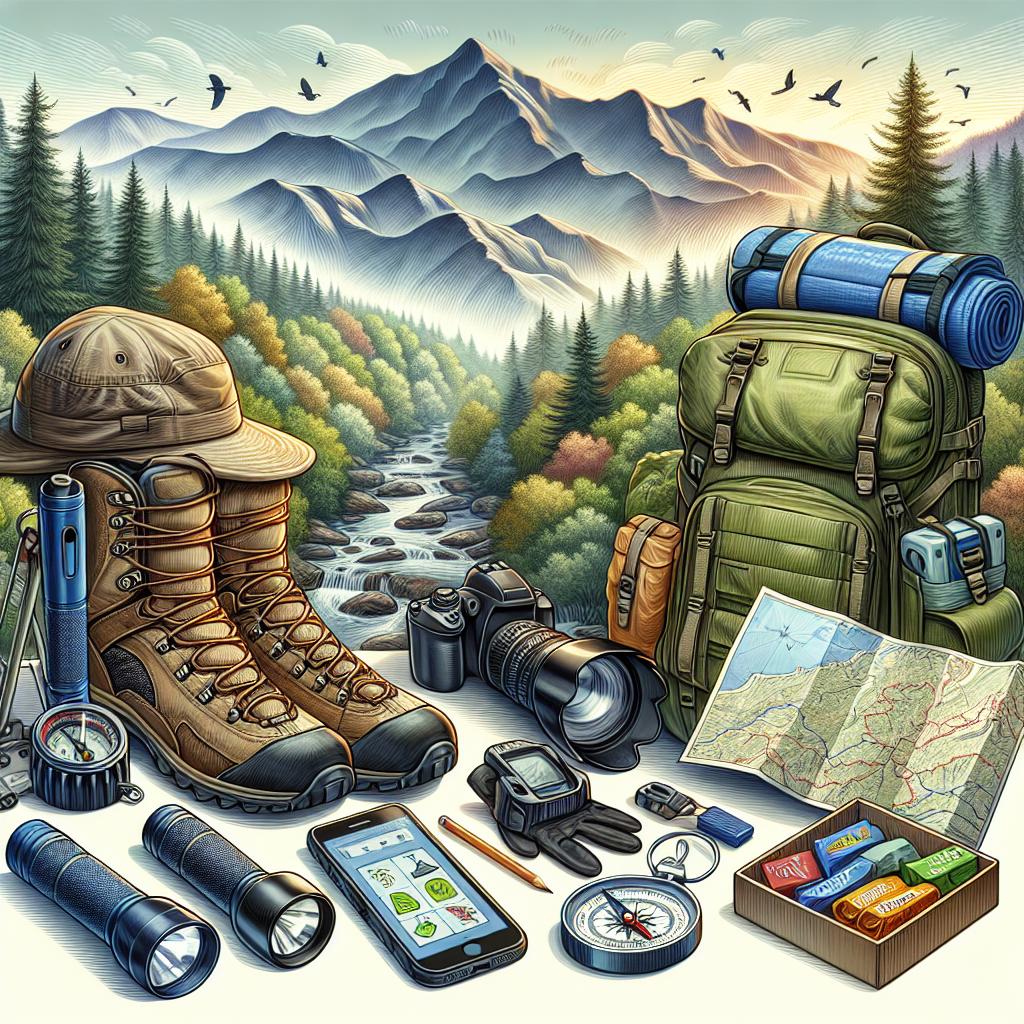Nestled in the heart of the Appalachian mountain range, where mist-kissed peaks meet verdant valleys, lies a natural wonder that’s both awe-inspiring and accessible—the Great Smoky Mountains. This vast expanse of rugged wilderness, cloaked in a mysterious blue haze, beckons hikers of all levels with its enchanting beauty and diverse trails. Whether you’re a seasoned trekker yearning for the thrill of steep ascents or a nature lover seeking serene woodland strolls, our “Ultimate Guide to Hiking in the Smoky Mountains” is your gateway to unparalleled adventure. Embark with us on a journey through this hiker’s paradise, where every path tells a story and every peak offers a promise of breathtaking vistas. Let’s lace up our boots and explore the grandeur that awaits beneath the Smokies’ timeless canopy.
Best Time to Trek the Trails: Seasonal Wonders of the Smoky Mountains
The Smoky Mountains put on a spectacular show each season, making it a year-round paradise for outdoor enthusiasts. In spring, flower lovers will revel in the symphony of wildflowers that blanket the trails, creating a vivid palette of colors. The crisp air, mild temperatures, and lively wildlife make it an ideal time to hit the pathways. Summer is equally captivating, with longer daylight hours offering more time to explore. Shaded trails and the occasional refreshing brook provide respite from the summer heat.
Come autumn, the Smokies transform into a kaleidoscope of fall foliage, drawing nature photographers and hikers eager to witness the breathtaking vistas. Cooler temperatures and fewer bugs make it comfy, while the vibrant leaves add an extra layer of magic. Winter, though brisk, rewards hardy trekkers with serene, snow-dusted landscapes and unparalleled clarity of views. Whether you’re a seasoned hiker or a novice, each season offers its unique allure, ensuring the Smoky Mountains never look the same twice.
Seasonal Highlights
- Spring: Flourishing wildflowers, mild temperatures, wildlife activity.
- Summer: Long daylight hours, shaded trails, refreshing brooks.
- Autumn: Stunning fall foliage, cooler temperatures, vibrant vistas.
- Winter: Snow-dusted landscapes, serene environments, clear views.
| Season | Highlights |
|---|---|
| Spring | Wildflowers, Wildlife Activity |
| Summer | Long Days, Shaded Trails |
| Autumn | Fall Foliage, Crisp Air |
| Winter | Snowy Views, Peaceful Trails |

Top Trails You Cannot Miss: From Easy Walks to Challenging Hikes
The Smoky Mountains offer an extraordinary variety of trails catering to every type of hiker. If you’re looking for easy walks, consider trails like Laurel Falls and Clingmans Dome. These trails are perfect for families and those who prefer a leisurely stroll through nature. You can enjoy spectacular views without the demanding effort of more rugged routes. Make sure to bring your camera, as these paths are known for their breathtaking beauty, especially during the autumn when the foliage is vibrant with color.
For those seeking a bit of a challenge, the Smoky Mountains do not disappoint. Trails like Alum Cave Bluffs and Charlies Bunion offer a more rigorous hiking experience. These paths reward perseverance with stunning, less-crowded vistas and a sense of accomplishment. Below is a table that summarizes some of the trails worth exploring:
| Trail Name | Difficulty | Distance (Round Trip) | Highlights |
|---|---|---|---|
| Laurel Falls | Easy | 2.6 miles | Waterfalls |
| Clingmans Dome | Easy | 1 mile | Observation Tower |
| Alum Cave Bluffs | Moderate | 4.4 miles | Arch Rock, Bluffs |
| Charlies Bunion | Strenuous | 8 miles | Panoramic Views |

Essential Gear for Your Smoky Mountains Adventure
Embarking on a hike in the Smoky Mountains requires careful preparation and the right equipment to ensure a safe and enjoyable experience. Here are a few of the essentials you should consider packing:
- Sturdy Footwear: Invest in a pair of quality hiking boots with good ankle support and tread to navigate the varied terrain.
- Navigation Tools: A map, compass, or GPS device can be a lifesaver if you stray off the main trails.
- Weather-Appropriate Clothing: Layering is key. Pack moisture-wicking base layers, insulating middle layers, and waterproof outer layers.
- Hydration and Snacks: A reusable water bottle and high-energy snacks like trail mix or energy bars will keep you fueled throughout your journey.
- First Aid Kit: Always carry a well-stocked first aid kit, including items like band-aids, antiseptics, and blister treatments.
Equipping yourself with the following will not only enhance your comfort but also ensure you are prepared for unexpected situations:
| Gear | Why It’s Essential |
|---|---|
| Headlamp or Flashlight | For visibility during early morning or late evening hikes. |
| Multi-tool or Knife | Useful for numerous tasks, from food preparation to gear repairs. |
| Bug Spray | Repels insects, which can be quite prevalent during certain seasons. |
| Emergency Shelter | Lightweight options like a bivy sack or space blanket can be crucial. |

Wildlife and Flora: What to Expect as You Explore
As you trek through lush trails, you’ll encounter an astonishing array of wildlife and flora that forms the heart of the Smoky Mountains. This region is renowned for its rich biodiversity, and you might spot everything from the elusive black bear to the vibrant Eastern tiger swallowtail butterfly. Keep your eyes peeled for these common wildlife sightings:
- Black Bears: Though sightings are rare, be alert and maintain a safe distance.
- White-tailed Deer: Often spotted grazing near the trails.
- Salamanders: Called the ”Salamander Capital of the World,” you might see them in streams and under logs.
- Birds: Including the red-tailed hawk and the colorful American goldfinch.
Flora enthusiasts will also be captivated by the variety of plant life in the Smoky Mountains. The area boasts over 1,500 types of flowering plants, each playing a unique role in the ecosystem. Some of the notable flora you might come across include:
| Plant | Description |
|---|---|
| Rhododendron | Abundant in the mountains; known for its stunning pink blooms. |
| Mountain Laurel | Another beautiful bloomer with intricate white and pink flowers. |
| Eastern Hemlock | A dominant tree species, providing shaded habitats and cool streams. |
| Fraser Fir | Found at higher elevations, these trees are often used as Christmas trees. |
Q&A
Q: What is the Smoky Mountains and why are they popular for hiking?
A: The Smoky Mountains, often referred to as the Great Smoky Mountains, are a subrange of the Appalachian Mountains stretching along the Tennessee-North Carolina border in the southeastern United States. Renowned for their mist-cloaked peaks, lush forests, and an incredible diversity of plant and animal life, they attract hikers from around the globe. The Smokies boast over 800 miles of maintained trails, offering options for everyone from novice hikers to seasoned adventurers. Their popularity is further bolstered by the stunning vistas, serene streams, and the opportunity to witness remnants of Appalachian history along the paths.
Q: When is the best time to hike in the Smoky Mountains?
A: The best time to hike in the Smoky Mountains depends on what you’re looking to experience. Spring, with its blooming wildflowers and comfortable temperatures, is ideal for flower enthusiasts and moderate hikers. Summer offers long daylight hours and lush greenery, perfect for family outings but sometimes crowded. Fall, arguably the crown jewel of hiking seasons here, dazzles with vibrant foliage and cooler weather, attracting leaf-peepers and photographers alike. Winter, although quieter, treats visitors to serene landscapes and occasional snow-dusted trails, making it a great time for tranquility seekers equipped for cold weather.
Q: What are some must-see trails in the Smoky Mountains?
A: The Smoky Mountains are brimming with iconic trails that showcase their natural beauty. Clingmans Dome, the highest peak in the Smokies at 6,643 feet, features a steep but short trail leading to a 360-degree observation tower. Alum Cave Trail, with its varied terrain and breathtaking views, leads to the LeConte Lodge, the only lodging on a peak in the park. For a water-centric experience, hike the Ramsey Cascades Trail to witness the park’s tallest waterfall. And for those yearning for a challenge, the Appalachian Trail runs through the Smokies offering some of its most rugged and rewarding sections.
Q: What should hikers be prepared for when hiking in the Smoky Mountains?
A: Hikers in the Smoky Mountains should be prepared for rapidly changing weather conditions, diverse wildlife encounters, and varied trail difficulties. Essential items include sturdy hiking boots, layered clothing, plenty of water, and nutritious snacks. A map or GPS device can be invaluable, as some trails traverse remote areas with limited cell reception. Hikers should also be knowledgeable about bear safety and follow Leave No Trace principles to preserve the delicate ecosystem. Lastly, carrying a first aid kit and informing someone of your hiking plans ensures added safety.
Q: Are there any restrictions or regulations hikers should be aware of?
A: Yes, the Great Smoky Mountains National Park has specific regulations to protect both hikers and the environment. Permits are required for backcountry camping, and certain areas may be off-limits during sensitive seasons for wildlife. Dogs are only allowed on two short walking paths, the Gatlinburg Trail and the Oconaluftee River Trail. Additionally, hikers should use designated trails to minimize erosion and respect all posted signs regarding closures or hazards. These regulations ensure that the park remains a pristine destination for future adventurers.
Q: Can you recommend any resources or guides for planning a hiking trip in the Smoky Mountains?
A: Absolutely! The official Great Smoky Mountains National Park website is a treasure trove of information, offering maps, trail descriptions, and updates on trail conditions. Printed guidebooks like “Hiking Trails of the Smokies” provide detailed insights and are great to have on hand. Local visitor centers also offer brochures and the latest news on trail closures or weather advisories. For a more personalized experience, consider hiring a local guide or joining a guided hiking tour to learn about the natural and cultural history of the area. Online communities and forums can also be invaluable for firsthand advice and tips.
In Summary
As your journey through the Ultimate Guide to Hiking in the Smoky Mountains draws to a close, consider this not an ending, but rather a beginning. Armed with insights, tips, and trails awaiting your footprints, you are now ready to embrace the serene beauty and rugged mastery of these storied peaks. Whether you’re seeking solitude in mist-laden mornings, the thrill of a challenging ascent, or simply the companionship of ancient trees and vibrant wildlife, the Smoky Mountains promise to share their secrets with those who wander wisely. So, lace up your boots, pack your sense of adventure, and step confidently into the wilderness. Your Smoky Mountains hike isn’t just a journey through nature – it’s a journey into the timeless tranquility and boundless wonders of the wild. Until then, may every trail leave you inspired, and every summit fill you with awe. Happy hiking!

